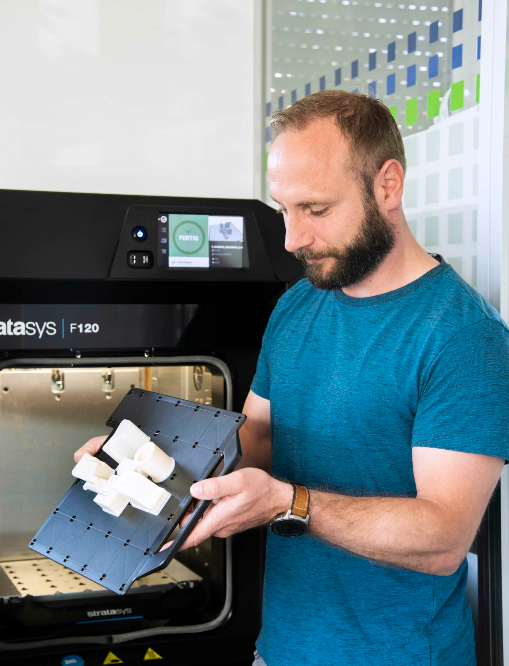3D Printing in Design and Mechanical Engineering
Definition and Benefits
3D printing is an additive manufacturing technology that creates objects layer by layer from a digital 3D model. This makes it an ideal technology for prototype production, as it allows for the creation of complex geometries and structures that are not possible with traditional methods.
What is the purpose of additive manufacturing?
In design, additive manufacturing is used to create prototypes of products and components. This enables designers to test and improve their designs before mass production begins. 3D-printed prototypes can also be used to gather customer feedback and ensure that products meet user requirements. In the past, expensive tools or molds had to be created to test or optimize a product, which took a lot of time.
Benefits of 3D Printing
Some of the advantages of using 3D printing for prototype manufacturing include:
- Faster and more cost-effective than traditional methods
- Enables the creation of complex geometries and structures
- Allows for rapid iterative development of designs
- Facilitates easy design adjustments based on customer feedback
- Enables the creation of prototypes for products that are not possible with traditional methods
The use of 3D printing in design is still relatively new, but the potential of this technology is enormous. 3D printing will change the way we develop products and components, helping to bring new and innovative products to the market. With 3D printing, designers can create their designs faster, more cost-effectively, and with greater flexibility.
When it comes to prototype manufacturing using 3D printing, both material and energy costs can be significantly reduced. In traditional prototyping, CNC milling is used to create a model from a large block of material, where material is removed to form the object. This process results in significant raw material waste. In 3D printing, however, only the material actually needed is used. Additionally, no special molds or tools need to be created.
Overall, this additive manufacturing technology has the potential to improve sustainability in product development, such as through the use of recycled materials. By adopting 3D printing, companies can make their products more sustainable and contribute to environmental protection.

Benefits for Design
The benefits of 3D printing in design summarized:
- Faster Development: 3D printing allows designers to create prototypes faster than with traditional methods. This can accelerate the development process and lead to new and innovative products.
- Reduced Costs: 3D printing can reduce the costs of prototype manufacturing, as it does not require the expensive tools or molds that traditional methods may need.
- Increased Flexibility: 3D printing enables designers to create prototypes with complex geometries and structures that would not be possible with traditional methods. This can lead to new and innovative products that better meet user requirements.
- Improved Quality: 3D printing can improve the quality of prototypes due to its precise and reproducible nature.
Additive Manufacturing in Mechanical Engineering
Challenges of 3D Printing in Mechanical Engineering:
- The costs of 3D printing have decreased, but further advancements are still needed to make the technology economically viable on a larger scale.
- When using 3D printers for mass production, the process must be scalable to meet the requirements (increasing production capacity, addressing bottlenecks).
- Ensuring consistently high quality of the printed products is essential. Therefore, developing standards and procedures for quality control is necessary.
- The selection of available materials for 3D printing in mechanical engineering needs to be expanded to better meet the demands.
The Future of 3D Printing in Mechanical Engineering
The use of additive manufacturing technologies in design and mechanical engineering will continue to grow in the coming years. This is because 3D printing offers a range of benefits that can enhance the development and production of products. 3D printing will change the way we develop and manufacture products, helping to bring new and innovative products to market that better meet user needs.
Unternehmen | About cts
Kontakt | Contact
Karriere | Career
Impressum | Imprint
Datenschutz | Privacy
AGB | GTC
Blog | News
Presse | Press
Glossar | Glossary

cts GmbH competence for technical solutions
Fuhrmannstraße 10
84508 Burgkirchen a.d. Alz
All rights reserved cts GmbH 2025 ©


